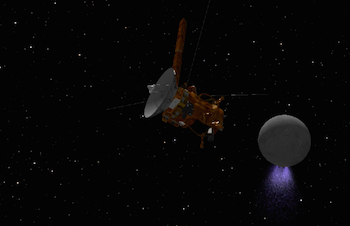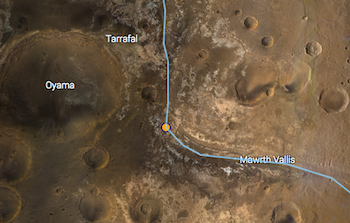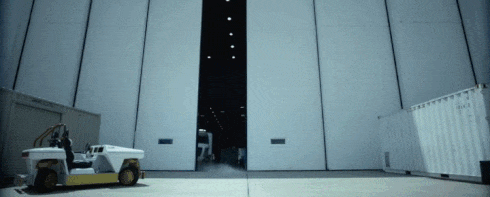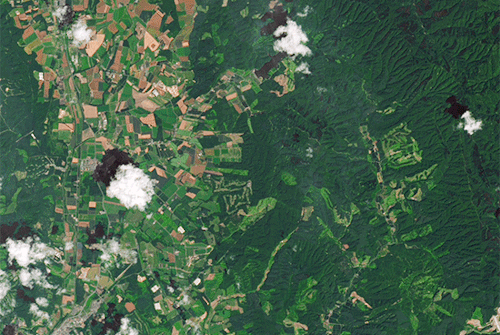Bend Your Mind With Special Relativity
Bend Your Mind With Special Relativity

Ever dreamed of traveling nearly as fast as light? Zipping across the universe to check out the sights seems like it could be fun. But, not so fast. There are a few things you should know before you jump into your rocket. At near the speed of light, the day-to-day physics we know on Earth need a few modifications. And if you’re thinking Albert Einstein will be entering this equation, you’re right!

We live our daily lives using what scientists call Newtonian physics, as in Isaac Newton, the guy who had the proverbial apple fall on his head. Imagine that you are on a sidewalk, watching your friend walk toward the front of a bus as it drives away. The bus is moving at 30 mph. Your friend walks at 3 mph. To you, your friend is moving at 33 mph — you simply add the two speeds together. (The 30 mph the bus is moving plus 3 mph that your friend is moving inside the bus.) This is a simple example of Newtonian physics.
However, imagine that your friend on the bus turns on a flashlight, and you both measure the speed of its light. You would both measure it to be moving at 670 million mph (or 1 billion kilometers per hour) — this is the speed of light. Even though the flashlight is with your friend on the moving bus, you still both measure the speed of light to be exactly the same. Suddenly you see how Einstein’s physics is different from Newton’s.

This prediction was a key part of Einstein’s special theory of relativity: The speed of light is the same for any observer, no matter their relative speed. This leads to many seemingly weird effects.
Before talking about those surprising effects, it’s good to take a moment to talk about point of view. For the rest of this discussion, we’ll assume that you’re at rest — sitting in one spot in space, not moving. And your friend is on a rocket ship that you measure to be traveling at 90% the speed of light. Neither of you is changing speed or direction. Scientists give this a fancy name — an “inertial frame of reference.”
With the stage set, now we can talk about a couple of super-weird effects of traveling near the speed of light. Relativity messes with simple things like distance and time, doing stuff that might blow your mind!

Let’s say you have a stick that is 36 inches long (91 centimeters). Your friend on the rocket doesn’t know the stick’s length, so they measure it by comparing it to a ruler they have as they zoom past you. They find your stick is just 16 inches (40 centimeters) long — less than half the length you measured! This effect is called length contraction. And if they were moving even faster, your friend would measure your stick to be even shorter. The cool thing about relativity is that both of those measurements are right! We see these effects in particle physics with fast-moving particles.
If your friend was traveling to our nearest neighbor star, Proxima Centauri, how far would they think it was? From Earth, we measure Proxima Centauri to be 4.2 light-years away (where one light-year is the distance light travels in a year, or about 5.8 trillion miles). However, your friend, who is traveling at 90% the speed of light in the rocket, would measure the distance between Earth and Proxima Centauri to be just over 1.8 light-years.
That’s just length … let’s talk about time!

Now let’s say you and your friend on the rocket have identical synchronized clocks. When your friend reaches Proxima Centauri, they send you a signal, telling you how long their trip took them. Their clock says the trip took just over two years. Remember, they measure the distance to be 1.8 light-years. However, you would see that your clock, which stayed at rest with you, says the trip took 4.7 years — more than twice as long!
This effect is called time dilation — time on moving clocks appears to tick slower.

None of this accounts for your friend accelerating their rocket or stopping at Proxima Centauri. All of this math gets more complicated if you and your friend were speeding up, slowing down, or changing directions. For instance, if your friend slowed down to stop at Proxima Centauri, they would have aged less than you on their trip!
Now you’re ready for a few tips on near-light-speed travel! Watch the video below for more.
Now, if you need to relax a bit after this whirlwind, near-light-speed trip, you can grab our coloring pages of scenes from the video. And if you enjoyed the trip, download a postcard to send to a friend. Finally, if you want to explore more of the wonders of the universe, follow NASA Universe on Facebook and Twitter.
Make sure to follow us on Tumblr for your regular dose of space: http://nasa.tumblr.com
More Posts from Nasa and Others
You’ve Heard “Houston, we’ve had a problem,” But Do You Know The Mission It’s From?
It’s the 50th anniversary of the Apollo 13 mission! NASA’s “successful failure,”Apollo 13 was to be the third lunar landing attempt, but the mission was aborted mid-flight after the rupture of a service module oxygen tank. The crew never landed on the moon, but due to the dedication and ingenuity of Mission Control, made it back to Earth safely. We’ve put some of the most important numbers of the Apollo 13 mission in perspective. Check it out!









Listen to the mission in real time, HERE.
Follow NASA History on Twitter and Facebook for more interesting information about aerospace history!
Check out the stats of all the Apollo Missions in the free e-book Apollo by the Numbers, HERE.
What kind of math is needed to get to Mars? How is the path of the lander calculated?
Solar System: Top 5 Things to Know This Week
1. A Ceres of Fortunate Events

Our Dawn mission continues its exploration at Ceres, and the team is working with the data coming back to Earth, looking for explanations for the tiny world’s strange features. Follow Dawn’s expedition HERE.
2. Icy Moon Rendezvous

One of the most interesting places in the entire solar system is Saturn’s moon Enceladus, with its underground ocean and spectacular geyser plume. This month, the Cassini spacecraft will be buzzing close by Enceladus several times, the last such encounters of the mission. On October 14, Cassini will perform a targeted flyby at a distance of just 1,142 miles (1,838 kilometers) over the moon’s northern latitudes. Ride along with Cassini HERE.
3. Make Your Own Mars Walkabout

You can retrace Opportunity’s journey, see where the Curiosity rover is now, or even follow along with fictional astronaut Mark Watney from The Martian movie using the free online app MarsTrek. The app lets you zoom in on almost any part of the planet and see images obtained by our spacecraft, so you can plan your on Red Planet excursion. Take a hike HERE.
4. Elusive Features on Jupiter

New imagery from our Hubble Space Telescope is capturing details never before seen on Jupiter. High-resolution maps and spinning globes, rendered in the 4K Ultra HD format, reveal an elusive wave and changes to Jupiter’s Great Red Spot. Explore Jupiter HERE.
5. Mr. Blue Sky

Another week, another amazing picture from Pluto. The first color images of Pluto’s atmospheric hazes, returned by our New Horizons spacecraft last week, reveal that the hazes are blue. Who would have expected a blue sky in the Kuiper Belt? Most of the data collected during July’s Pluto flyby remains aboard the spacecraft, but the team publishes new batches of pictures and other findings on a weekly basis. Keep up with the latest HERE.
Make sure to follow us on Tumblr for your regular dose of space: http://nasa.tumblr.com
Hi! When did you know that you wanted to become an astronaut?
As a kid, I thought being an astronaut was the coolest thing, but I never thought I’d be selected. While working at the CIA, I decided to go out and apply because I thought it was my last chance to actually apply.
The Search for Starless Planets
While it’s familiar to us, our solar system may actually be a bit of an oddball. Our Milky Way galaxy is home to gigantic worlds with teeny-tiny orbits and planets that circle pairs of stars. We’ve even found planets that don’t orbit stars at all! Instead, they drift through the galaxy completely alone (unless they have a moon to keep them company). These lonely island worlds are called rogue planets.

Where do rogue planets come from?
The planet-building process can be pretty messy. Dust and gas around a star clump together to form larger and larger objects, like using a piece of play-dough to pick up other pieces.
Sometimes collisions and close encounters can fling a planet clear out of the gravitational grip of its parent star. Rogue planets may also form out in space on their own, like the way stars grow.

Seeing the invisible
We’ve discovered more than 4,000 exoplanets, but only a handful are rogue planets. That’s because they’re superhard to find! Rogue planets are almost completely invisible to us because they don’t shine like stars and space is inky black. It’s like looking for a black cat in a dark room without a flashlight.
Some planet-finding methods involve watching to see how orbiting planets affect their host star, but that doesn’t work for rogue planets because they’re off by themselves. Rogue planets are usually pretty cold too, so infrared telescopes can’t use their heat vision to spot them either.
So how can we find them? Astronomers use a cool cosmic quirk to detect them by their effect on starlight. When a rogue planet lines up with a more distant star from our vantage point, the planet bends and magnifies light from the star. This phenomenon, called microlensing, looks something like this:

Imagine you have a trampoline, a golf ball, and an invisible bowling ball. If you put the bowling ball on the trampoline, you could see how it made a dent in the fabric even if you couldn’t see the ball directly. And if you rolled the golf ball near it, it would change the golf ball’s path.

A rogue planet affects space the way the bowling ball warps the trampoline. When light from a distant star passes by a rogue planet, it curves around the invisible world (like how it curves around the star in the animation above). If astronomers on Earth were watching the star, they’d notice it briefly brighten. The shape and duration of this brightness spike lets them know a planet is there, even though they can’t see it.

Telescopes on the ground have to look through Earth’s turbulent atmosphere to search for rogue planets. But when our Nancy Grace Roman Space Telescope launches in the mid-2020s, it will give us a much better view of distant stars and rogue planets because it will be located way above Earth’s atmosphere — even higher than the Moon!
Other space telescopes would have to be really lucky to spot these one-in-a-million microlensing signals. But Roman will watch huge patches of the sky for months to catch these fleeting events.

Lessons from cosmic castaways
Scientists have come up with different models to explain how different planetary systems form and change over time, but we still don’t know which ones are right. The models make different predictions about rogue planets, so studying these isolated worlds can help us figure out which models work best.
When Roman spots little microlensing starlight blips, astronomers will be able to get a pretty good idea of the mass of the object that caused the signal from how long the blip lasts. Scientists expect the mission to detect hundreds of rogue planets that are as small as rocky Mars — about half the size of Earth — up to ones as big as gas giants, like Jupiter and Saturn.

By design, Roman is only going to search a small slice of the Milky Way for rogue planets. Scientists have come up with clever ways to use Roman’s future data to estimate how many rogue planets there are in the whole galaxy. This information will help us better understand whether our solar system is pretty normal or a bit of an oddball compared to the rest of our galaxy.

Roman will have such a wide field of view that it will be like going from looking at the cosmos through a peephole to looking through a floor-to-ceiling window. The mission will help us learn about all kinds of other cool things in addition to rogue planets, like dark energy and dark matter, that will help us understand much more about our place in space.
Learn more about the Roman Space Telescope at: https://roman.gsfc.nasa.gov/

Make sure to follow us on Tumblr for your regular dose of space: http://nasa.tumblr.com
Tour NASA with One Direction

You might have heard, One Direction filmed their ‘Drag Me Down’ music video at NASA’s Johnson Space Center, and we know you’re dying to take a tour of everything they saw. So, here we go…
1) Space Exploration Vehicle (SEV)

Even though Louis is roving around Johnson Space Center in our Space Exploration Vehicle, its intended destination is quite different. The SEV will be used for in-space missions and for surface explorations of planetary bodies, including near-Earth asteroids and Mars!
2) Robonaut
Harry and Robonaut bonded during their visit to Johnson Space Center for the filming of their music video. This robot will help humans work and explore in space. Working side by side with humans, or going where the risks are too great for people, robots will make it so we never get ‘dragged down’!
3) Partial Gravity Simulator & Space Station Mockup Bike

You can find Niall floating around in our Partial Gravity Simulator, aka POGO, in the new music video. This tool is used to provide accurate simulations of reduced gravity. Astronauts use this for training and to learn how to perform tasks in space.
While Niall floats with POGO, Liam is training on the International Space Station Mockup Bike, aka CEVIS. This bike provides aerobic exercise and is used to countermeasure the harmful effects of exposure to microgravity while on the space station.
4) Orion Spacecraft

The Orion spacecraft will be the first of its kind that will carry humans to deep space and to Mars! It will be the safest, most advanced spacecraft ever built, and Harry, Niall, Louis and Liam all got to check it out.
5) T-38 Jets

Flying these T-38 jet trainers are an important part of preparing to be an astronaut. Flying and landing them acts as a real-life simulation for practicing spacecraft operations. They can even fly at supersonic up to Mach 1.6, and can put their pilots through more than seven Gs!

Landslides in Japan
On Sept. 6, 2018, shortly after the remnants of Typhoon Jebi drenched southern Hokkaido, a powerful earthquake rattled the Japanese island. The 6.6-magnitude quake shook the surface enough to unleash hundreds of landslides.
The Landsat 8 satellite acquired imagery of the widespread damage. An image acquired on Sept. 15, 2018, shows mud and debris in a hilly area east of Abira. For comparison, the previous image shows the same area on July 26, 2017.
Read more about this
Make sure to follow us on Tumblr for your regular dose of space: http://nasa.tumblr.com.
Does all capsules drops in Kazakhstan on return after every mission?
Since the US Space Shuttle retired in 2011, we launch to and return from the Space Station with the Russian Space Agency. So yes, these capsules (the Soyuz) land in Kazakhstan (or surrounding regions). However, different spacecrafts have different reentry trajectories, depending on where they aim to land. As you might recall, the Apollo mission capsules landed in the ocean. Since Space-X and Boeing are currently building new vehicles so that we will also launch from the US again to get to the International Space Station, these spacecraft will return to the US. For example, you may have seen footage of Space-X cargo vehicles splashing down into the Pacific over the last few years. The Boeing Starliner plans to land on land instead of water. NASA is also currently building the Orion spacecraft, which will take us to destinations beyond low earth orbit (where the Space Station is), whether that be the Moon or Mars or another target. Orion will also splash down in the ocean.
What’s Up for June 2017?
Have a planet party and compare Saturn and Jupiter! We’ll show you where and when to point your telescope or binoculars to see these planets and their largest moons.

Meet at midnight to have a planetary party when Jupiter and Saturn are visible at the same time!

The best time will be after midnight on June 17. To see the best details, you’ll need a telescope.

Saturn will be at opposition on June 15, when Saturn, the Earth and the sun are in a straight line.

Opposition provides the best views of Saturn and several of its brightest moons. At the very least, you should be able to see Saturn’s moon Titan, which is larger and brighter than Earth’s moon.

As mentioned earlier, you’ll be able to see Jupiter and Saturn in the night sky this month. Through a telescope, you’ll be able to see the cloud bands on both planets. Saturn’s cloud bands are fainter than those on Jupiter.

You’ll also have a great view of Saturn’s Cassini Division, discovered by astronomer Giovanni Cassini in 1675, namesake of our Cassini spacecraft.

Our Cassini spacecraft has been orbiting the planet since 2004 and is on a trajectory that will ultimately plunge it into Saturn’s atmosphere on September 15, 2017, bringing the mission to a close.

Our Juno spacecraft recently completed its sixth Jupiter flyby. Using only binoculars you can observe Jupiter’s 4 Galilean moons - Io, Callisto, Ganymede and Europa.

To learn about What’s Up in the skies for June 2017, watch the full video:
For more astronomy events, check out NASA's Night Sky Network at https://nightsky.jpl.nasa.gov/.
Make sure to follow us on Tumblr for your regular dose of space: http://nasa.tumblr.com
Celebrating Five Years at Jupiter!
We just released new eye-catching posters and backgrounds to celebrate the five-year anniversary of Juno’s orbit insertion at Jupiter in psychedelic style.

On July 4, 2016, our Juno spacecraft arrived at Jupiter on a mission to peer through the gas giant planet’s dense clouds and answer questions about the origins of our solar system. Since its arrival, Juno has provided scientists a treasure trove of data about the planet’s origins, interior structures, atmosphere, and magnetosphere.

Juno is the first mission to observe Jupiter’s deep atmosphere and interior, and will continue to delight with dazzling views of the planet’s colorful clouds and Galilean moons. As it circles Jupiter, Juno provides critical knowledge for understanding the formation of our own solar system, the Jovian system, and the role giant planets play in putting together planetary systems elsewhere.
Get the posters and backgrounds here!
For more on our Juno mission at Jupiter, follow NASA Solar System on Twitter and Facebook.
Make sure to follow us on Tumblr for your regular dose of space!
-
 championsbigtranstits liked this · 4 weeks ago
championsbigtranstits liked this · 4 weeks ago -
 prjulioca liked this · 1 year ago
prjulioca liked this · 1 year ago -
 throndogorth liked this · 1 year ago
throndogorth liked this · 1 year ago -
 smaugbornassassin reblogged this · 1 year ago
smaugbornassassin reblogged this · 1 year ago -
 shennanigoats liked this · 1 year ago
shennanigoats liked this · 1 year ago -
 mph67st liked this · 2 years ago
mph67st liked this · 2 years ago -
 ethereal-jikook liked this · 2 years ago
ethereal-jikook liked this · 2 years ago -
 climbhighsleeplow liked this · 2 years ago
climbhighsleeplow liked this · 2 years ago -
 mindscapesunny liked this · 2 years ago
mindscapesunny liked this · 2 years ago
Explore the universe and discover our home planet with the official NASA Tumblr account
1K posts